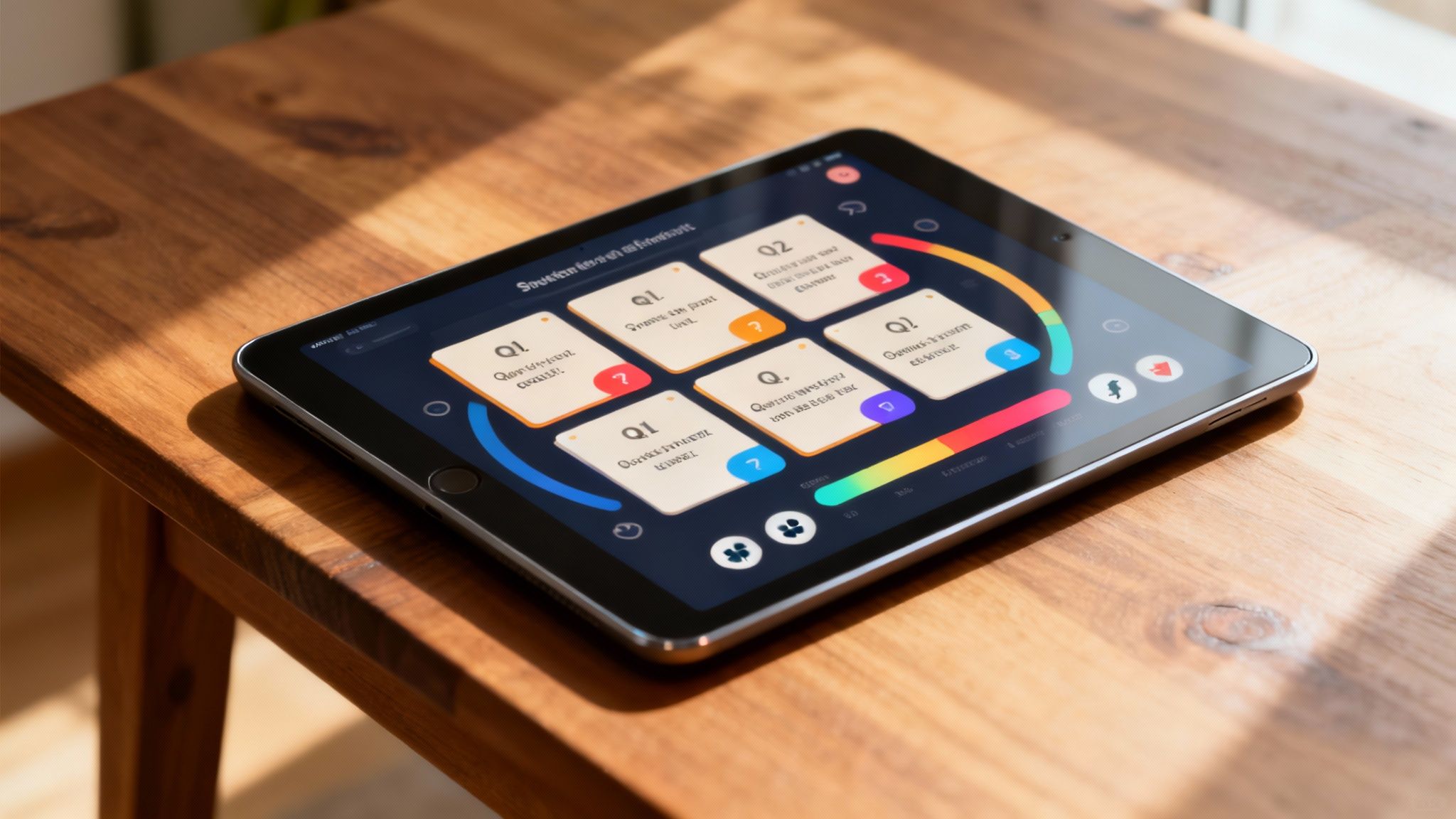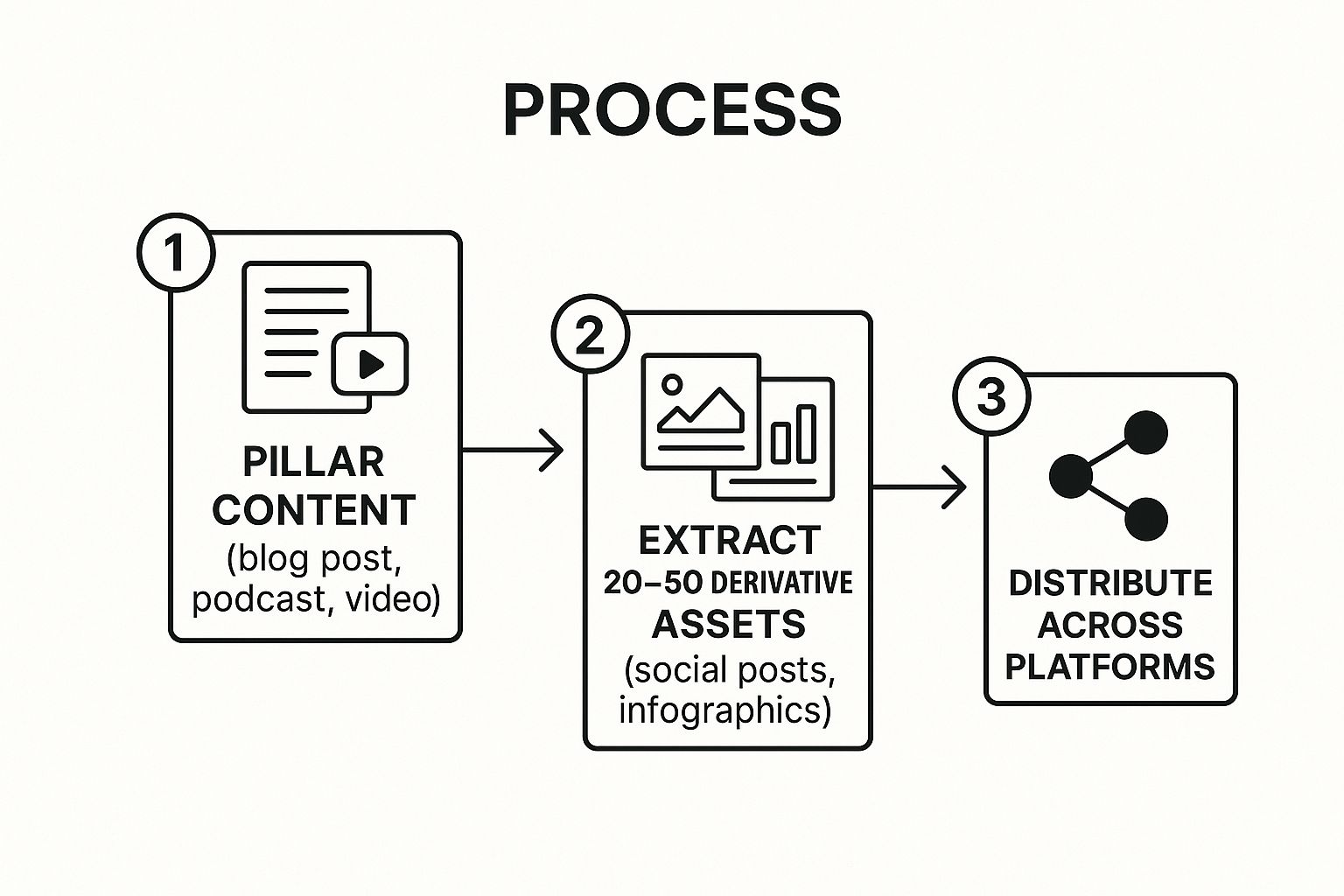
Staring at a blank content calendar can be one of the most frustrating challenges for any digital marketer, creator, or startup founder. The constant pressure to produce fresh, engaging material often leads to creative burnout, leaving you wondering where the next great idea will come from. This content creation paralysis is a common pain point that can halt your marketing momentum. But what if you had a playbook of proven content creation ideas to turn to for sustained inspiration and engagement?
This article is your new go-to resource. We’re breaking down 10 versatile content formats that consistently deliver results, from building authority with in-depth tutorials to fostering community with user-generated campaigns. We’ll provide actionable strategies and real-world examples to help you execute each idea effectively. Get ready to transform your creative process from a persistent challenge into a strategic advantage, ensuring your content calendar is packed with high-performing assets for months to come.
1. Tutorial and How-To Content
Tutorial and how-to content is a cornerstone of effective digital marketing, designed to teach your audience a specific skill or solve a particular problem through step-by-step instructions. This format directly addresses user search intent, as people constantly turn to the internet to learn how to do something. By breaking down complex processes into digestible, actionable guides, you establish your brand as a helpful authority and a reliable resource. This is one of the most powerful content creation ideas for building trust and organic traffic.

This approach is highly versatile. A B2B software company might create a detailed video walkthrough of a new feature, while a freelance graphic designer could offer a blog post on "5 Steps to Creating a Brand Style Guide." The key is to provide clear, immediate value that empowers your audience. For example, a digital marketing agency could create a guide on using AI for marketing; see how you can create effective marketing content with AI on mediaworkbench.ai.
How to Implement This Idea
- Identify Common Pain Points: Use tools like AnswerThePublic or browse forums like Reddit and Quora to find recurring problems your target audience faces.
- Choose the Right Format: A complex software tutorial benefits from a screen-recorded video, while a recipe works well as a blog post with high-quality photos.
- Structure for Clarity: Use numbered lists, headings, and bold text to make your instructions easy to follow. In videos, use timestamps so viewers can jump to specific sections.
2. Behind-the-Scenes Content
Behind-the-scenes (BTS) content offers your audience an authentic, unpolished look into the inner workings of your brand. This approach pulls back the curtain on your processes, workspace, and team dynamics, giving followers exclusive access to the reality behind the finished product. By revealing the human element of your work, you build a powerful connection based on transparency and relatability. This is one of the most effective content creation ideas for humanizing a brand and fostering deep community trust.

This strategy is highly adaptable. A marketing agency could share a video of a team brainstorming session for a new client campaign. A solopreneur could post an Instagram Story showing how they package and ship their products. The goal is to make your audience feel like insiders. Even showing challenges, like a product delay with a transparent explanation, builds far more trust than silence. This vulnerability makes your brand more approachable and trustworthy.
How to Implement This Idea
- Document, Don't Create: Share your daily workflow rather than trying to create perfectly staged content. Think team meetings, project kick-offs, or the step-by-step process of creating a deliverable.
- Introduce Your Team: Put a face to the brand by featuring employees. A day-in-the-life story from a project manager creates personal connections.
- Use Ephemeral Formats: Instagram and Facebook Stories are perfect for spontaneous, in-the-moment BTS content that doesn't need to be polished, creating a sense of urgency and exclusivity.
3. User-Generated Content Campaigns
User-generated content (UGC) campaigns encourage your customers and followers to create and share content featuring your brand. This strategy leverages authentic testimonials and creative expressions from real users, transforming your audience from passive consumers into active brand advocates. By showcasing genuine experiences, you build powerful social proof and a strong sense of community around your products or services. This is one of the most effective content creation ideas for generating trust at scale.
This method taps into the innate desire for people to share their stories and be recognized. Iconic examples include GoPro's adrenaline-fueled #GoPro photos and Apple's stunning #ShotOniPhone campaign, both of which turn customer content into high-impact marketing assets. For a marketing agency, this could be a campaign asking clients to share their biggest win using the hashtag #AgencySuccess, with the best story getting featured in a case study. The core principle is to give your audience a reason to create and a platform to be seen.
How to Implement This Idea
- Create a Branded Hashtag: Develop a clear, memorable, and unique hashtag that is easy to spell and directly related to your brand or campaign.
- Offer Clear Incentives: Motivate participation by offering prizes, discounts, or the chance to be featured on your official channels. Recognition is often as powerful as a monetary reward.
- Set Simple, Clear Guidelines: Make participation as easy as possible. Avoid complex rules that might deter users.
- Promote and Engage: Actively promote your campaign and engage with every submission by liking, commenting, and sharing to show appreciation and encourage more participation.
4. Interactive Content (Quizzes, Polls, Assessments)
Interactive content transforms your audience from passive consumers into active participants. Formats like quizzes, polls, calculators, and assessments require user input, creating a two-way dialogue that boosts engagement and provides personalized value. Instead of just telling your audience something, you invite them to discover insights about themselves. This makes the experience more memorable and is one of the most effective content creation ideas for capturing valuable audience data and generating leads.

This approach is highly effective for lead generation. A digital marketing agency could create an "SEO Score Calculator" that provides a free audit in exchange for an email. A freelance consultant could design a "What's Your Productivity Style?" quiz that offers tailored tips. The key is that the user receives immediate, customized results, making the interaction feel worthwhile. Furthermore, running these campaigns is a great way to boost visibility; discover how to manage these campaigns effectively with social media automation software.
How to Implement This Idea
- Focus on Value-Driven Outcomes: Design your interactive content to solve a problem or answer a compelling question for the user.
- Gate Results for Lead Generation: Offer a summary of the results immediately, but require an email address to unlock a more detailed report or personalized guide.
- Promote Social Sharing: Include prominent social sharing buttons on the results page. Craft shareable result titles like "I'm a 'Creative Visionary'! What's your marketing style?" to encourage sharing.
👉 Try MediaWorkbench.ai for free – schedule your posts and generate AI content in one place!
5. Case Studies and Success Stories
Case studies and success stories are powerful narratives that provide evidence of your product's or service's real-world value. By documenting how a specific customer overcame a challenge and achieved measurable results, you move beyond marketing claims and into concrete proof. This format builds immense trust and credibility by showcasing tangible outcomes, making it one of the most persuasive content creation ideas for converting prospects in the consideration stage of their journey.
This approach validates your offerings by letting satisfied customers do the selling for you. For a B2B SaaS company like MediaWorkbench.ai, a case study could detail how a marketing agency used its automation tools to reduce content creation time by 40% while increasing client engagement by 25%. This metric-driven proof is invaluable for potential B2B clients. The format is versatile and can be a detailed blog post, a compelling video testimonial, or a downloadable PDF for sales teams.
How to Implement This Idea
- Identify Ideal Candidates: Look for clients who have achieved remarkable, measurable results and represent your target audience.
- Structure Your Narrative: Follow a clear problem-solution-result framework. A popular method is the STAR format: Situation (the initial challenge), Task (the goal), Action (the steps taken using your product), and Result (the measurable outcome).
- Quantify the Success: Use hard data to make the story compelling. Include specific metrics like percentage increases in revenue, hours saved, or growth in user engagement. Numbers provide undeniable proof of value.
6. Listicles and Curated Roundups
Listicles and curated roundups are a highly effective content format structured as numbered or bulleted lists that compile information, resources, or tips around a specific theme. This scannable format is designed for modern readers, delivering quick value while being exceptionally SEO-friendly and shareable. By organizing information into a digestible and easy-to-follow list, you cater to audiences seeking fast, actionable answers, making this one of the most reliable content creation ideas for driving traffic and engagement.
This approach is extremely versatile. A creator-focused startup could publish "15 Must-Have AI Tools for Solopreneurs," while a digital marketer might write "9 Common Mistakes to Avoid in Your Next Email Campaign." The core appeal lies in its promise of a finite, organized set of information, which simplifies complex topics and makes the content feel more approachable and less intimidating for the reader.
How to Implement This Idea
- Choose a Compelling Number and Topic: Use specific, often odd, numbers in your title (e.g., "17 Essential Tools..." instead of "Top Tools") as they tend to attract more clicks.
- Structure for Skimmability: Use clear headings for each list item and incorporate visuals like images or screenshots to break up text and add context.
- Provide Genuine Insight: Avoid creating a superficial list. For each item, add your own unique perspective or experience. You can use pre-made templates as a starting point; for instance, you can explore social media marketing templates on mediaworkbench.ai to streamline your process.
7. Live Streaming and Real-Time Content
Live streaming is the practice of broadcasting video content in real-time to engage audiences with unscripted, authentic interactions. This format creates a powerful sense of urgency and exclusivity, encouraging viewers to tune in at a specific time. By enabling direct, two-way communication through live chats and Q&A sessions, you can build a vibrant community and foster a deep, personal connection with your audience. This is one of the most effective content creation ideas for humanizing your brand and creating simultaneous shared experiences.
This approach thrives on platforms like Instagram Live, LinkedIn Live, and YouTube. A digital marketing expert could host a weekly live Q&A session on LinkedIn to answer questions about AI in content creation. A startup could use Instagram Live to host a product demo and get instant feedback from potential users. The unscripted nature of live content makes it feel more genuine and trustworthy than highly polished, pre-recorded videos.
How to Implement This Idea
- Promote Your Stream: Announce your live event 24-48 hours in advance across all your channels to build anticipation and maximize attendance.
- Prepare and Test: Test your technology before going live. Prepare a loose outline of talking points but remain flexible enough to interact with your audience.
- Engage Actively: The core of live streaming is interaction. Acknowledge viewers by name, answer their questions as they come in, and respond to comments.
- Repurpose the Content: After the stream ends, save the recording. You can upload the full video to YouTube or clip the best moments for social media shorts.
8. Repurposed and Atomized Content
Repurposed and atomized content is a strategic framework for maximizing the value of a single, substantial piece of work by breaking it down into numerous smaller assets. Instead of constantly creating from scratch, this method involves taking a “pillar” asset—like a long-form blog post, podcast, or webinar—and slicing it into dozens of smaller, platform-specific pieces. This approach dramatically increases your content output and reach without a proportional increase in effort, making it one of the most efficient content creation ideas for modern marketers.
The following infographic illustrates the core process flow of content atomization, from a single pillar asset to broad multi-platform distribution.

As shown, the model begins with a high-value content pillar and systematically breaks it down into derivative assets tailored for widespread distribution, multiplying its impact. For example, a marketing agency’s webinar on "AI for Social Media" can be atomized into a blog post summarizing key takeaways, an Instagram carousel with top tips, a series of short video clips for TikTok, and a downloadable PDF checklist for lead generation. This extends the life and reach of the initial investment.
How to Implement This Idea
- Start with a Pillar Asset: Identify a robust piece of content that is rich with information, such as a detailed research report, an in-depth video interview, or a comprehensive guide.
- Extract Key Insights and Snippets: Systematically pull out key quotes, statistics, actionable tips, and compelling stories.
- Adapt for Each Platform: A quote from a blog post becomes a graphic for Instagram, a section from a podcast becomes an audiogram for LinkedIn, and a key statistic becomes a tweet.
- Create a Content Matrix: Track your pillar asset and all its derivative pieces in a spreadsheet to manage distribution and avoid repetition.
9. Trend Jacking and Newsjacking
Trend jacking, and its close cousin newsjacking, is a content strategy focused on capitalizing on current events, viral moments, or trending topics to amplify your brand's reach. By tapping into a conversation that already has massive public interest, you can insert your brand into the cultural zeitgeist, demonstrating relevance and personality. This is one of the most agile content creation ideas for capturing immediate attention and boosting visibility.
This approach leverages existing momentum. Famous examples include Oreo's iconic "You can still dunk in the dark" tweet during the 2013 Super Bowl blackout. A more current example would be a marketing automation tool like MediaWorkbench.ai creating content around a major social media platform's algorithm change, explaining how its features can help creators adapt. The key is to act with speed and relevance.
How to Implement This Idea
- Monitor Trends Proactively: Use social listening tools to monitor trending hashtags and topics on platforms like X (formerly Twitter), TikTok, and Instagram.
- Act with Speed and Relevance: The window for a trend is often very short. You must have a rapid internal process to create and publish content quickly.
- Add Value, Don't Just Report: Offer a unique perspective or helpful insight that connects the trend to your audience's interests. To execute this effectively, you need a streamlined workflow; explore how to build a powerful content process with marketing automation best practices to stay ahead.
Power out? No problem. pic.twitter.com/dnQ7pOgC
— OREO Cookie (@Oreo) February 4, 2013
10. Educational Series and Content Courses
An educational series or content course takes your audience on a structured learning journey, guiding them through a specific topic in a sequential, in-depth manner. This approach positions your brand as a leading expert by delivering comprehensive value far beyond a single blog post. By creating a curriculum-style experience, you build immense authority and nurture a dedicated community. This is one of the most powerful content creation ideas for building long-term loyalty and creating high-value brand assets.
This format is incredibly effective for converting followers into customers because it demonstrates profound expertise over time. A productivity tool for freelancers could create a free email course on "5 Days to a More Organized Solopreneur Business." This not only provides immense value but also naturally showcases how the tool fits into the solution. The goal is to provide a complete transformation, taking a user from beginner to competent in a particular skill.
How to Implement This Idea
- Define a Clear Learning Outcome: What specific skill or knowledge will your audience have after completing the series?
- Break It Down into Modules: Segment your topic into 5-12 digestible lessons and release them on a consistent schedule to build anticipation.
- Vary Your Content Formats: Combine video lessons with downloadable worksheets, checklists, and quizzes. For guidance on creating educational content, master online course design ideas to boost engagement.
- Build a Community: Create a dedicated space like a private group or forum where students can ask questions and share progress.
Conclusion
The journey from a blank page to a high-performing piece of content doesn't have to be a struggle. We've explored ten powerful formats—from the trust-building transparency of behind-the-scenes content to the authority-cementing power of educational series. Each idea offers a unique pathway to connect with your audience, solve their problems, and achieve your marketing goals. The key is to move from inspiration to implementation by building a sustainable system that allows you to consistently execute your best ideas.
To make these content creation ideas work, align your chosen format with your audience's needs, embrace content repurposing to maximize your efforts, and mix and match formats for a dynamic content calendar. Mastering these concepts is essential for any digital agency, creator, or marketer looking to thrive in a crowded landscape. By centralizing your workflow with a unified platform, you can remove the operational friction that stifles creativity and focus on what you do best: creating exceptional content.
Ready to turn your best content creation ideas into reality without the hassle? Media Workbench AI provides a unified platform to generate text, create stunning visuals, and schedule your posts all in one place. Stop juggling tabs and start building a seamless content engine. Explore our features and see how you can supercharge your content workflow today.

